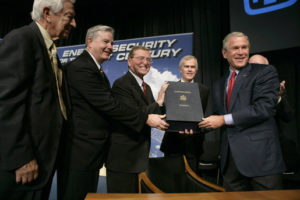
President George W. Bush holds the box containing the energy bill after signing the H.R. 6, The Energy Policy Act of 2005 at Sandia National Laboratory in Albuquerque, New Mexico, Monday, Aug. 8, 2005. (White House photo)
In the aftermath of 9/11, energy independence became a driving force for President George W. Bush, and he saw the potential for our nation’s productive farmers to help attain that goal.
The Energy Policy Act of 2005 was signed on August 8 of that year at Sandia National Laboratory in Albuquerque, New Mexico symbolizing a new approach to energy economics and security, diversifying our transportation fuel supply by incentivizing ethanol and biodiesel.
“The bill includes a flexible, cost-effective renewable fuel standard that will double the amount of ethanol and biodiesel in our fuel supply over the next seven years,” said President Bush. “Using ethanol and biodiesel will leave our air cleaner. And every time we use a home-grown fuel, particularly these, we’re going to be helping our farmers, and at the same time, be less dependent on foreign sources of energy.”
In 2005, there were 81 ethanol plants in the United States, production was less than 4 billion gallons a year, and corn was averaging $2 per bushel. Three years later, in 2008, production was 9.4 billion gallons with almost 140 plants on-line and corn was $7 a bushel.
President Bush understood the American farmer and he understood that fuel could be made from crops and that it could help make our country more energy independent.
“I like to say that someday a President is going to pick up the crop report and they’re going to say we’re growing a lot of corn, and — or soybeans — and the first thing that’s going to pop in the President’s mind is, we’re less dependent on foreign sources of energy. It makes sense to promote ethanol and biodiesel.”
(Introduction to “Ethanol: America’s Fuel”)
Listen to part of Pres. Bush’s remarks 20 years ago today:
Pres. Bush 2005 Energy Bill Signing 3:17

